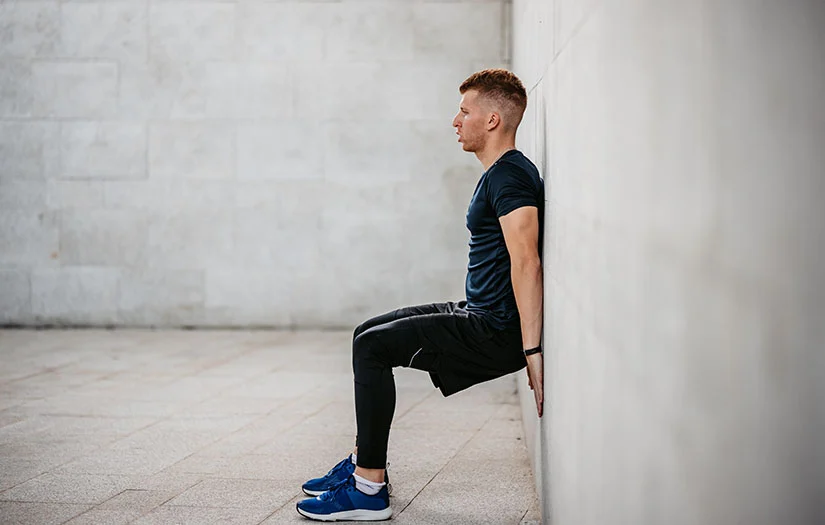By
When I was a student-athlete, wall sits were frequently used as a “character-building” exercise for the whole team. Character-building exercises were typically exercises that required perseverance and grit to push through to the end, thus building our character. As a team, we’d all line up on the wall in a squat position as our coach set the timer to infinity.
The crazy thing is that wall sitting looks like the easiest exercise, but the quad burn is real! You don’t know how long 60 seconds is until you’ve tried a 60-second wall sit. This simple yet effective exercise is great for building muscular endurance in the legs and engaging the core, and it can be done just about anywhere!
You can find other exercises and demonstrations within the NASM exercise library.
THE BASICS: HOW TO DO A WALL SIT
Anyone can perform a wall sit because they are simple to perform, and they don’t require any equipment. Find a sturdy wall to lean against and give it a try:
• Stand with your back flat against a wall and walk your feet out away from the wall about 2 feet, with your feet hip to shoulder-width apart.
• Slowly sink into a squat position, keeping your back against the wall, and bend your legs until your hips, knees, and ankles are each at a 90-degree angle.
• Hold this position while keeping good form (back flat against the wall, abs tight, weight in the centre of the foot)
• Push through your feet to stand up out of the wall and sit when the time is up.
Tips for beginners:
1. Start with a shorter amount of time, like 20-30 seconds. Perform your wall sits 2-3 times per week to build strength and endurance. Each week, add 5-10 seconds to your goal time until you can hold the wall sit position for an entire minute.
2. Don’t sink to 90 degrees the first time you try a wall sit. Instead, try stopping when the hips are just above the knees so that it’s easier to get out of the wall sit position. Over time, try to get lower until you can hold and get out of the 90-degree squat position.
STABILITY BALL WALL SIT
Using a stability ball to perform your wall sit is a great way to add challenge to the core since the surface that you’re leaning against isn’t as stable as the wall. The move is the same, except there’s a stability ball between you and the wall. Here’s how to do it:
• Place a ball against the wall, and stand leaning back against the ball with the ball lined up behind your low back. Walk your feet out about 2 feet from the ball, with your feet hip to shoulder-width apart and feet straight, so you’re leaning back against the ball.
• Slowly sink into a squat position, keeping your back against the ball, and bend your legs until your hips, knees, and ankles are each at a 90-degree angle.
• Hold this position while keeping good form (shoulders back, abs tight, weight in the centre of the foot).
• Push through your feet to stand up from the stability ball wall and sit when the time is up.
ADDING EXERCISES TO YOUR WALL SIT
One common complaint about the wall sit (besides extreme quad burn!) is boredom while holding the position. If you enjoy multi-tasking, or you want to engage more muscle groups while working the legs, give some of these variations a try:
Add Biceps Curls
In the wall sit position, perform biceps curls (together or alternating) to work the biceps while those legs burn.
Add Shoulder Raises
Using dumbbells, you can add:
• Front raises- raising the dumbbells to shoulder height or eye level.
• Scaption (also called V-raises) – raising the dumbbells to shoulder height or eye level in the scapular plane (not straight forward, not out to the side, but right in between).
• Lateral raises – raising the dumbbells straight out to your sides making a letter “T” with your arms.
Using a medicine ball, you can add a front raise. Start with the medicine ball at the thighs, and raise it to eye level, or overhead if the form will allow it without arching the low back.
ADD WOOD CHOPS
Use a piece of weighted equipment (a dumbbell, medicine ball, kettlebell, etc.) to perform a diagonal chopping motion while sitting on your wall sit. Start by holding the weight with both hands down at one hip.
Keep your abs tight and arms straight as you raise the weight in a diagonal pattern toward the opposite shoulder. During the chopping motion, keep your abs tight and your back pressed against the wall. Keep chopping on that one side for half of the time, and then switch to the other side for the remaining time.
ADVANCED: ADD A MARCH
Keep the upper body still as you lift one foot off the ground while holding the wall sit. Alternate legs to do a marching movement without shifting your upper body position.
Progress your way there: Start by lifting just one heel off the ground, hold for 2 seconds, and then return the heel to the ground and switch. You can gradually lift more of your foot off the ground until you can fully lift your foot off the floor without shifting your weight.
BENEFITS OF WALL SITS
Wall sits increase muscular endurance and joint stabilization in a squat position. They work the quads (no question there), the glutes, the calves, and the core (especially as you focus on good posture in this position!).
Better muscular endurance in squats translates over into less quad fatigue when performing activities that require extended use of the quads like skiing, sports requiring an athletic stance, or even hiking and biking. Sports-specific training is recommended for optimal performance in activities like skiing, hiking, and biking, but you should notice a difference in your stamina in everyday activities like walking, climbing stairs, and being able to easily get in and out of a chair simply by adding wall sits to your routine.
DO WALL SITS HELP WITH MOBILITY?
A wall sit is an isometric movement- one where a position is held still for some time. Although it is not intended as a stretch, for someone who has limited mobility in their hips, knees, and ankles, sinking into a wall sitting may feel like a stretch (literally). In this way, the exerciser increases their mobility as they hold the squat position, while also improving stability around the joints during the isometric hold. The key is to find a squat position that is challenging, yet comfortable enough to hold for the allotted time.
SUMMARY
As much as I hate to admit it, my coaches were onto something with having us do wall sits! Wall sits are a great addition to a well-rounded fitness program. They are easy to do on the go, during a break at work, or at the end of a challenging workout to build muscular endurance in the legs. If you’re looking for a fun challenge for your legs that you can do just about anywhere, wall sits are a fantastic option.
THE AUTHOR

KINSEY MAHAFFEY
Kinsey Mahaffey, MPH, is a Houston-based fitness educator, personal trainer and health coach who developed her commitment to lifelong fitness while playing Division I volleyball. She’s passionate about helping others cultivate a healthy lifestyle and enjoys educating other fitness professionals who share this vision. She’s a Master Instructor and Master Trainer for NASM.

